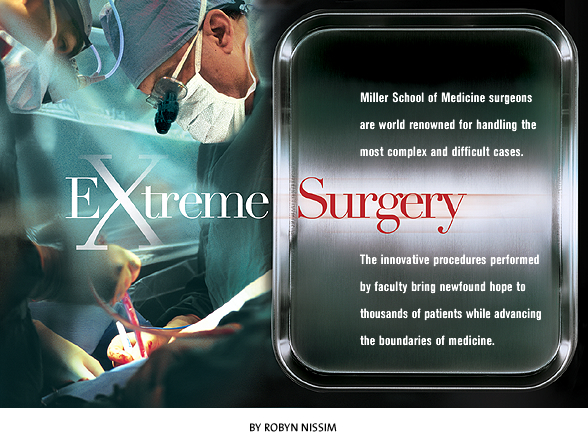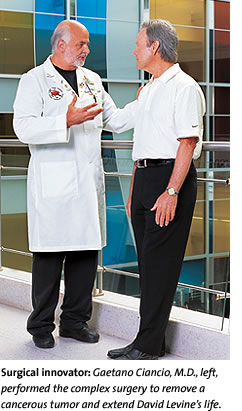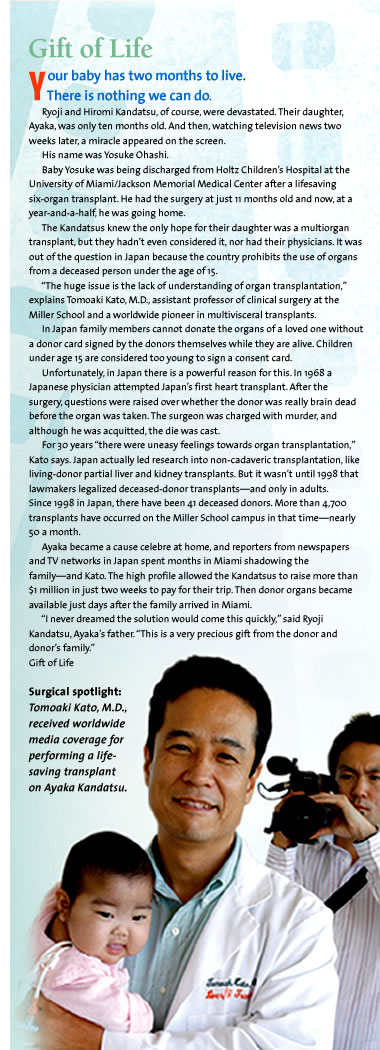
 n her first birthday, Ayaka Kandatsu wore the dress
she was supposed to be buried in. Her grandmother bought the dress for
the gravely ill infant before she traveled halfway around the world to
receive a lifesaving transplant from Tomoaki Kato, M.D., Andreas Tzakis,
M.D., Ph.D., and other members of the GI transplant team at the University
of Miami Leonard M. Miller School of Medicine/Jackson Memorial Medical
Center. Ayaka’s family flew more than 17 hours from Tokyo to Miami
because she was unable to receive a transplant in Japan—children
under 15 cannot donate organs. Few centers—only two or three in
the United States—actually perform multivisceral transplants, the
simultaneous transplantation of the abdominal organs. And of all the
transplant centers worldwide, Miller School of Medicine surgeons have
performed more multivis-ceral transplants than any other. Half of all
the multivisceral transplants ever performed were done at UM/JMMC.
n her first birthday, Ayaka Kandatsu wore the dress
she was supposed to be buried in. Her grandmother bought the dress for
the gravely ill infant before she traveled halfway around the world to
receive a lifesaving transplant from Tomoaki Kato, M.D., Andreas Tzakis,
M.D., Ph.D., and other members of the GI transplant team at the University
of Miami Leonard M. Miller School of Medicine/Jackson Memorial Medical
Center. Ayaka’s family flew more than 17 hours from Tokyo to Miami
because she was unable to receive a transplant in Japan—children
under 15 cannot donate organs. Few centers—only two or three in
the United States—actually perform multivisceral transplants, the
simultaneous transplantation of the abdominal organs. And of all the
transplant centers worldwide, Miller School of Medicine surgeons have
performed more multivis-ceral transplants than any other. Half of all
the multivisceral transplants ever performed were done at UM/JMMC.
Multivisceral transplants and other dramatic procedures, such as the removal of a teenager’s 16-pound facial tumor, make headlines, but those are just a few of the accomplishments of UM’s DeWitt Daughtry Family Department of Surgery.
UM surgeons are renowned throughout the world for their daring, innovative techniques and willingness to take on cases that others deem hopeless. “There’s a common denominator in all of these procedures—there’s a serious problem that cannot be resolved with the existing technologies, and you need to develop an alternative that will take care of the problem,” says Tzakis, director of the Division of Liver and Gastrointestinal Transplantation.
“We remove tumors that no one else will do. We perform transplants that no other center can perform. We have trauma patients that we see and save and send home,” says Alan Livingstone, M.D., chairman of the Department of Surgery. “The reason we can do these things is because of the personnel we have—experts who are here all the time. The average general surgeon would see these things once in a lifetime. We see them every week.”
Miami’s large, diverse population ensures both volume and variety of surgical cases, but the skill and dedication of UM’s surgeons have resulted in more novel treatments. “The operations that are devised are a lot of times the end products of long experience in both humans and animals,” Tzakis says. “We know what worked and what has not worked from our work and the work of other investigators. We stretch out this knowledge to reach the problem at hand and take care of our patient.”
Improving the Quality of Life for All
![]() avid Levine had a serious problem that no one was
willing to address.
avid Levine had a serious problem that no one was
willing to address.
In 2005 Levine was diagnosed with renal cell carcinoma. The 60-year-old attorney from Kendall had a tumor that had grown from his kidney to the inferior vena cava, the vein that brings the blood from the lower part of the body into the heart. It is an uncommon, asymptomatic disease—Levine’s cancer was discovered after he passed out suddenly while in the backyard and went to the emergency room—and it is very deadly. The physician at Baptist Hospital who treated Levine told him he was unable to perform the surgery needed to remove the tumor, but he knew someone who could: Gaetano Ciancio, M.D.
Ciancio, a UM transplant surgeon, has developed a unique approach to resect these tumors. Using transplant techniques, the operation essentially moves the liver away from the inferior vena cava and then clamps off the right atrium so that the tumor that has grown from the kidney into the veins and heart can be removed. Each surgery is designed according to the extension of the tumor.
 Ciancio has never turned down a patient suffering
from this disease nor has he lost one during surgery. Insurance does
not cover these surgeries because they
do not exist in the books, so UM/Jackson ends up subsidizing the procedure.
Ciancio has never turned down a patient suffering
from this disease nor has he lost one during surgery. Insurance does
not cover these surgeries because they
do not exist in the books, so UM/Jackson ends up subsidizing the procedure.
But “if they can’t find hope at UM, where else can they go?” says Ciancio.
Ciancio was able to remove Levine’s tumor. One year later, Levine’s cancer has spread throughout his body. But he “would have been dead very quickly without that surgery,” Levine says. Ciancio “saved my life.”
As he does with all of these highly complex renal cell carcinomas, Ciancio relied on a team that includes Mark Soloway, M.D., chairman of the Depart-ment of Urology, and Tomas Salerno, M.D., chief of cardiothoracic surgery, to attack the disease. “The team you work with helps to grow that desire to make things better,” Ciancio says.
The majority of these patients do not live past a year or two even with a successful resection. “This is a chance to give patients months or years. If we haven’t found a way to help people in whatever way, why are we here? There is no price for one year of life,” Ciancio says.
“We try to improve the quality of life for all.”
A ‘Futuristic Surgeon’
![]() r.
Salerno felt there was a need to change the way cardiothoracic surgery
was performed. In standard cardiac surgery, the
patient is placed on
a heart-lung machine, the aorta is clamped, the heart is stopped with
potassium, the patient is cooled, and then the heart is opened. “The
heart will have no circulation for periods varying from an hour to three
or four hours, so it sustains a tremendous ischemic insult,” Salerno
says. “If you cut off the circulation to your brain for three minutes,
you would be dead. If you did this to your kidneys for one hour, your
kidneys would not make urine. Heart surgeons do this routinely for two
to three hours.”
r.
Salerno felt there was a need to change the way cardiothoracic surgery
was performed. In standard cardiac surgery, the
patient is placed on
a heart-lung machine, the aorta is clamped, the heart is stopped with
potassium, the patient is cooled, and then the heart is opened. “The
heart will have no circulation for periods varying from an hour to three
or four hours, so it sustains a tremendous ischemic insult,” Salerno
says. “If you cut off the circulation to your brain for three minutes,
you would be dead. If you did this to your kidneys for one hour, your
kidneys would not make urine. Heart surgeons do this routinely for two
to three hours.”
After years of research in myocardial protection, Salerno pioneered a way of operating on the heart without stopping it, known as “beating heart surgery.”
Patients do immeasurably better with this technique, Salerno says. “Hypothermia has a lot of side effects. Imagine putting your hand in a bucket of icy water for two hours—how cold it gets and then how it swells when you warm it up. The same happens in the heart.”
 Beating heart surgery enables Salerno to take on “very high-risk operations,
patients that have poor ventricular function. When you take them to the operating
room, you don’t have heart injury.” Another benefit is that “patients
don’t like to have their hearts stopped. So it’s very appealing for
patients to know that they’re not going to be cold, the heart is not going
to be stopped, and I’m going to be operating with their heart beating.”
Beating heart surgery enables Salerno to take on “very high-risk operations,
patients that have poor ventricular function. When you take them to the operating
room, you don’t have heart injury.” Another benefit is that “patients
don’t like to have their hearts stopped. So it’s very appealing for
patients to know that they’re not going to be cold, the heart is not going
to be stopped, and I’m going to be operating with their heart beating.”
Salerno’s beating heart surgical technique has been controversial. “When we developed warm heart surgery nobody wanted to use it, and everybody hated my guts for this,” he says, citing resistance to change as one of the reasons. “I don’t care what other people think. I’m not here to be popular—I’m here to provide a service for my patients.” Hundreds of patients later, Salerno has seen success with his revolutionary technique and is training the next generation of surgeons to operate using his maverick method.
Randy Stevens, M.D., is a cardiothoracic surgeon in the last year of his fellowship. He plans on using beating heart surgery techniques when he becomes an attending.
“There are a lot of challenges in operating on a beating heart,” he says. “If you were a hunter, it would be like trying to shoot a deer that’s standing still versus the deer that’s moving at 15 miles an hour. So it requires different techniques completely because the heart never stops moving. But the advantage to this technique is that you never, ever make the heart more ischemic than it might already be. Because there is the understanding that even with the best myocardial protection, you’re still making the heart ischemic, and ischemia has its costs.” Other benefits that surgeons in training see are that patients don’t need as much post-surgical support in the way of medications, they don’t seem to have as much irritability of the heart, and they recover much faster.
“Dr. Salerno doesn’t speak much about himself, but he’s a true pioneer and a very futuristic surgeon, so he’s not constrained by normal approaches,” Stevens adds. “He’s willing to offer new techno-logy. And I think that’s one of the big draws to this program—having him here, the history of the program, and this being a large, well-respected academic institution.”
Six Organs, Seven Organs, Eight Organs—More?
![]() n Andreas Tzakis’s office is a wall full of photos of patients on whom
he has performed transplants. He can name them all and tell you the story behind
each picture. They are what drive Tzakis and the other transplant surgeons to
push the boundaries of medicine further and further. “When we do these
extreme procedures, we do believe these are the best alternatives for these patients,” Tzakis
says.
n Andreas Tzakis’s office is a wall full of photos of patients on whom
he has performed transplants. He can name them all and tell you the story behind
each picture. They are what drive Tzakis and the other transplant surgeons to
push the boundaries of medicine further and further. “When we do these
extreme procedures, we do believe these are the best alternatives for these patients,” Tzakis
says.
“I have a lot of fear when I do any operation, particularly with new ones or procedures that you consider extreme. But I do not remember ever in my life taking a risk that I did not absolutely have to.”
Since Tzakis came to Miami in 1994, the one-year survival rate of intestinal transplant recipients has doubled: Nearly 80 percent now make it past the first year, which significantly increases their chances of long-term survival. That remarkable achievement is due in no small part to surgeons who’ve focused on eliminating complications, Tzakis says.
David Levi, M.D., worked on a method of re-creating an abdominal wall by transplanting the abdominal wall from cadavers. Tomoaki Kato, M.D., introduced the use of a magnifying scope that helps surgeons figure out rejection faster and has concentrated on pediatric transplants, just as Tzakis did earlier in his career. Seigo Nishida, M.D., tirelessly worked on studying the course of every patient and improving outcomes. Debbie Weppler, R.N., and Lesli Kravetz, R.N., are “hands- on” leaders of a team of nurses who make sure that the patients are prepared for surgery and later are safe at home.
Surgeons like Tzakis are never complacent.
“The next leap is wherever there is need. The big leap is not from doing seven organs to eight organs. That’s a nice thing to do for the Guinness Book of World Records. From the human standpoint, it’s also a nice thing to do because we take care of somebody we couldn’t take care of before.
“What is next? Whatever is needed. We have the technology to do many more organs simultaneously. A lot of the pieces of the puzzle are already there. We have to fill in the image and fit the pieces in a way that would fit for the patient.”
Whatever is next, it’s likely to be done first at the University of Miami.